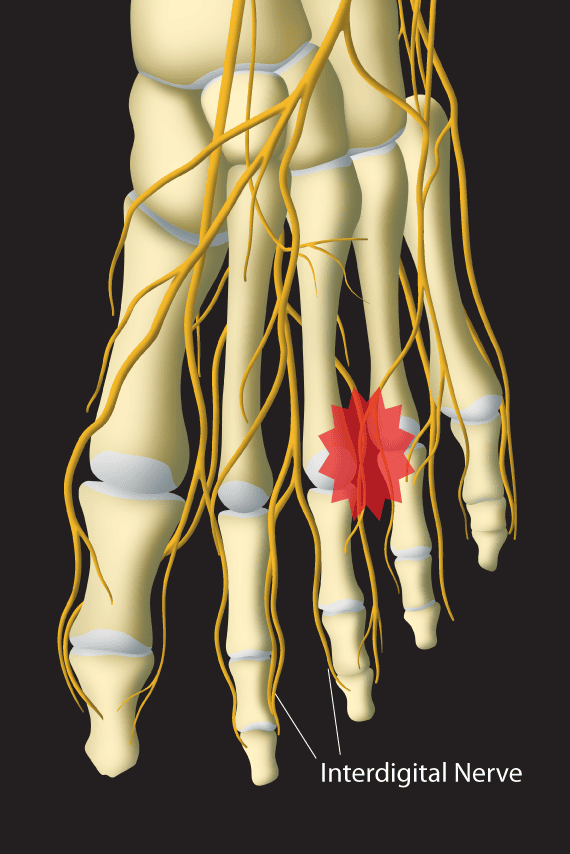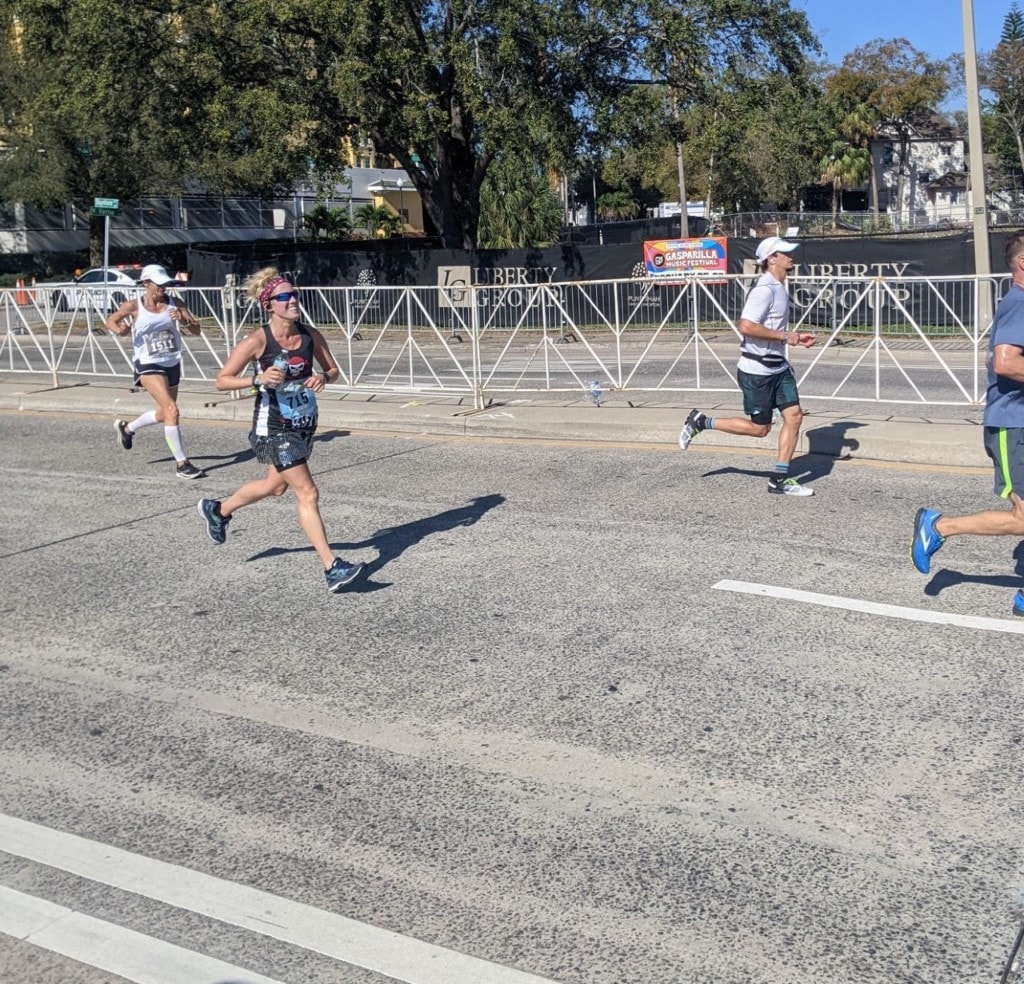Morton’s Neuroma: Understanding This Common Foot Condition

Medically Reviewed By:
Foot pain can significantly affect daily activities, making even simple movements uncomfortable. This discomfort can be particularly challenging for those who spend extensive time on their feet. Morton’s neuroma is a condition that frequently disrupts mobility and quality of life.
Below is an overview of Morton’s neuroma, including its causes, symptoms, and approaches for managing this condition.
What Is Morton’s Neuroma?
Morton’s neuroma involves swelling of a nerve located between the bones at the front of the foot, known as the metatarsals. This swelling affects the interdigital nerve, which runs between these bones, and can cause symptoms ranging from a mild sensation similar to walking on a small object to more intense, radiating pain.
Wearing tight or narrow shoes often worsens discomfort by increasing pressure on the nerve, leading to further irritation.

Why Nerve Pain Develops In The Ball Of The Foot
Nerve pain in the ball of the foot, as seen in conditions like Morton’s neuroma, often results from physical stress and lifestyle factors. Understanding the underlying causes and risk factors can explain why this discomfort develops and what may exacerbate it.
Improper Footwear
Wearing tight, narrow, or high-heeled shoes can place excessive pressure on the front of the foot. This added pressure compresses the nerves between the toes, increasing the risk of irritation. Choosing supportive, well-fitted shoes may help alleviate this stress on the foot’s structure.
Foot Structure
Some foot shapes, such as flat feet or high arches, can increase pressure on the ball of the foot, making nerve compression more likely. Proper support may help balance pressure and reduce irritation in these areas.
Repetitive Stress
Activities that place repeated stress on the forefoot, such as running, jumping, or prolonged standing, may lead to nerve irritation over time. Reducing repetitive impact and allowing for rest may help manage and prevent irritation.
Injuries
Previous foot injuries, such as fractures, sprains, or trauma to the forefoot, may contribute to nerve irritation. Proper rehabilitation may support healing and help reduce the risk of long-term discomfort.
Other Medical Conditions
Certain medical conditions may increase the risk of nerve pain in the ball of the foot, as they often lead to structural changes or additional pressure on nerves:
- Bunions: Bony bumps that shift foot alignment, increasing pressure on nearby nerves.
- Hammertoes: Abnormal bending of the toes that may contribute to nerve irritation.
- Arthritis: Joint inflammation that alters foot mechanics, adding stress to the nerves.
How To Recognize Morton’s Neuroma Symptoms
Recognizing the signs of Morton’s neuroma can help guide individuals toward the most suitable management options. Symptoms may vary in intensity and can worsen with prolonged standing or while wearing tight footwear. Common symptoms include:
- Sharp Foot Pain Radiating To The Toes: Intense, shooting pain that may spread from the ball of the foot to the toes.
- Pebble Sensation Under The Forefoot: A sensation as if there’s a small object underfoot, often causing discomfort when walking.
- Numbness Or Tingling In The Toes: A sensation of numbness or “pins and needles” affecting the toes.
- Heel Pain: Heel pain may be caused by conditions such as plantar fasciitis, Achilles tendonitis, or a heel spur. Accompanying symptoms can include sharp or aching pain, stiffness, and discomfort that may worsen with walking or prolonged standing. Read More About Heel Pain.
- Ankle Soreness After Walking: Ankle soreness after walking may result from overuse, improper footwear, joint inflammation, or an underlying condition such as arthritis or tendonitis. Symptoms may include pain, stiffness, or swelling, often worsening with prolonged activity. Read More About Ankle Soreness After Walking.
- Big Toe Numbness: Numbness in the big toe may result from nerve compression, poor circulation, or underlying conditions like neuropathy. It can cause reduced sensation, tingling, or weakness, sometimes affecting balance and mobility. Read More About Big Toe Numbness.
Diagnosing Nerve-Related Foot Pain
Diagnosing Morton’s neuroma typically involves a thorough evaluation by a physician, which may include:
- Medical History and Symptom Review: Assessing symptoms, prior foot injuries, and lifestyle factors
- Physical Examination: Identifying tenderness, swelling, or foot structure abnormalities
- Imaging tests: X-rays rule out fractures, while ultrasounds and MRIs help visualize soft tissues, including nerves.
- Diagnostic Nerve Block: Temporarily numbing the affected nerve to determine if pain relief occurs
Exploring Treatment Options For Morton’s Neuroma
Treating Morton’s neuroma often involves a combination of lifestyle changes and therapeutic approaches aimed at reducing nerve pressure and alleviating discomfort. Here are some commonly recommended treatment options:
- Changing Shoe Type: Avoiding high heels or shoes with a tight-toe box
- Activity Restriction: Reducing activities that cause repetitive stress on the forefoot
- Physical Therapy: Exercises and stretches that relieve tension and improve circulation
- Non-Steroidal and Inflammatory Drugs (NSAIDs): Nonsteroidal anti-inflammatory drugs (NSAIDs) help reduce pain and inflammation in conditions affecting joints, muscles, and the spine. While they provide temporary relief, prolonged use may increase heart, kidney, and gastrointestinal risks, requiring careful management. Read More About NSAIDs.
- Alcohol Injections: Used to ablate (destroy) the affected nerve
- Surgical Excision: Removing the interdigital nerve when other measures fail
Physicians may use injections prepared from the body’s own platelets to target the irritated nerve in Morton’s neuroma. These injections deliver growth factors that stimulate tissue repair, improve circulation, and reduce inflammation. They support the healing environment around the nerve and may relieve pain and improve foot function without relying on surgery.
Are There More Options For Managing The Condition?
Rather than relying on steroid injections, which may affect long-term tissue health, some patients explore other approaches, like interventional orthobiologics.
Physicians in the licensed Regenexx network may use platelet-based injectates to help manage symptoms related to Morton’s neuroma. Regenexx’s proprietary lab processing allows for greater precision and consistency than standard bedside centrifuge systems.
Using this approach, physicians can tailor formulations—such as Regenexx-SCP and Regenexx-PL—to meet the specific needs of the condition. These treatments aim to reduce nerve irritation and improve foot function without relying on corticosteroids or surgery.
While research on platelet-rich plasma (PRP) specifically for the interdigital nerve is still in its early stages, PRP has demonstrated positive results in multiple randomized controlled trials for treating carpal tunnel syndrome, a comparable condition affecting nerves in the wrist.
The video above provides an example of an ultrasound-guided hydro dissection performed around the median nerve. From the physician’s perspective, this procedure involves using advanced ultrasound imaging to guide a needle around the targeted nerve accurately.
By visualizing the surrounding structures in real-time, the physician can precisely place the injected solution, which helps to separate and protect the nerve from surrounding tissues.
A Runner’s Morton’s Neuroma Journey

Regenexx licenses its proprietary injectates and processes to a network of independent physicians who provide regenerative orthobiologic procedures. This field focuses on less invasive procedures using Regenexx injectates derived from the patient’s own body to treat orthopedic conditions. To learn more, see the video below:
This patient case is shared by Dr. Papas in Tampa. His patient, a 31-year-old female long-distance runner, initially experienced unusual sensations in her third and fourth toes. She noticed these symptoms primarily after running distances over 5 miles.
Following a diagnosis of Morton’s neuroma by a podiatrist, she received multiple steroid and alcohol injections, which provided only brief relief. She underwent multiple injections over time but continued to experience discomfort, which eventually led to severe pain while walking barefoot.
Upon examination, Dr. Papas noted significant muscle atrophy in her feet, likely due to the numerous injections. He implemented a treatment plan involving three rounds of ultrasound-guided platelet lysate injections around Morton’s neuroma, complemented by physical therapy. After each round, her running tolerance gradually improved, and the muscle atrophy was no longer observed during follow-up.
The patient has returned to running long distances and is now setting personal records. Recently, she participated in all races at the Gasparilla Festival, including the 5K, 8K, 15K, and half marathon—some of which were run consecutively. She has reported improved comfort while running long distances. .
The Regenexx Approach To Managing Nerve-Related Foot Pain
Morton’s neuroma can significantly affect mobility and quality of life. While some patients opt for steroid or alcohol injections or even surgery, these options may not be suitable for everyone and can have associated risks.
Procedures using Regenexx injectates aim to support the body’s natural healing process and may help reduce pain and improve function.
If you are experiencing persistent foot pain, consulting with a physician in the licensed Regenexx network may help you explore non-surgical options.
Get started to see if you are a Regenexx candidate
To talk one-on-one with one of our team members about how the Regenexx approach may be able to help your orthopedic pain or injury, please complete the form below and we will be in touch with you within the next business day.

Medically Reviewed By:
